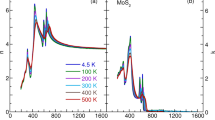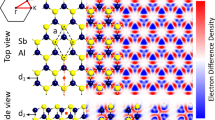Abstract
The present work shed light on the structural, electronic, dielectric, and optical properties of MT2 (M = Ba, Hf, Si, Sr and T = F, O) two-dimensional (2D) monolayers using density functional theory. The investigated electronic properties indicate that these 2D monolayer materials exhibit insulating properties. The complex dielectric function is calculated to investigate the optical functions of these monolayer materials. The dielectric and optical calculations are performed for the electric field vectors’ orientation parallel (E||x, i.e., in-plane direction) and perpendicular (E||z, i.e., out-of-plane direction) to the plane of these 2D monolayer materials in the energy range 0–60 eV. It is noticed that the dielectric and optical responses of BaF2, HfO2, and SrF2 are shifted toward the lower energy in the ultraviolet (UV) region compared to SiO2. It may be attributed to their larger ionic radii. Due to a similar chemical environment, the studied properties show similar behavior in BaF2 and SrF2. These 2D materials offer high absorption of incident light in a wide energy range of UV region, hence the higher extinction coefficient. The obtained reflection and transmission coefficients in the vacuum ultraviolet (VUV) wavelength region suggest the potential candidature of these materials for VUV optical coatings, such as reflection, bandpass, absorption edge filters, and avoiding solar heating. BaF2 and SrF2 can combine to make low–high refractive index pair material with high refractive index HfO2. The present results indicate that these 2D monolayer materials may be potential candidates for designing optical, photonic, and optoelectronic devices.




Similar content being viewed by others
References
Ambrosch-Draxl, C., Sofo, J.O.: Linear optical properties of solids within the full-potential linearized augmented planewave method. Comput. Phys. Commun. 175, 1–14 (2006). https://doi.org/10.1016/j.cpc.2006.03.005
Austria, H.F.M., Subrahmanya, T.M., Setiawan, O., Widakdo, J., Chiao, Y.H., Hung, W.S., Wang, C.F., Hu, C.C., Lee, K.R., Lai, J.Y.: A review on the recent advancements in graphene-based membranes and their applications as stimuli-responsive separation materials. J. Mater. Chem. a. 9, 21510–21531 (2021). https://doi.org/10.1039/d1ta04882a
Calzolari, A., Catellani, A., Nardelli, M.B., Fornari, M.: Hyperbolic metamaterials with extreme mechanical hardness. Adv. Opt. Mater. 9, 2001904-13 (2011)
Castro Neto, A.H., Guinea, F., Peres, N.M.R., Novoselov, K.S., Geim, A.K.: The electronic properties of graphene. Rev. Mod. Phys. 81, 109–162 (2009). https://doi.org/10.1103/RevModPhys.81.109
Fukuda, M., Zhang, J., Le, Y.-T., Ozaki, T.: A structure map for AB2 type 2D materials using high-throughput DFT calculations. Mater. Adv. 2, 4392–4413 (2021)
Geim, A.K., Novoselov, K.S.: The rise of graphene. Nat. Mater. 6, 183–191 (2007)
Golosov, D.A., Vilya, N., Zavadski, S.М, Melnikov, S.N., Avramchuk, A.V., Grekhov, ММ, Kargin, N.I., Komissarov, I.V.: Influence of film thickness on the dielectric characteristics of hafnium oxide layers. Thin Solid Films 690, 137517-6 (2019). https://doi.org/10.1016/j.tsf.2019.137517
Hoat, D.M., Silva, J.F.R., Blas, A.M., Rámirez, J.J.R.: Effect of pressure on structural, electronic and optical properties of SrF2: a first principles study. Rev. Mex. Fis. 64, 94–100 (2018). https://doi.org/10.31349/RevMexFis.64.94
Hohenberg, P., Kohn, W.: Inhomogeneous electron gas. Phys. Rev. 136, B864–B871 (1964)
Illarionov, Y.Y., Waltl, M., Di Bartolomeo, A., Genovese, L., Illarionov, Y.Y., Rzepa, G., Waltl, M., Knobloch, T., Grill, A.: The role of charge trapping in MoS2/SiO2 and MoS2/hBN field-effect transistors. 2D Mater. 3, 1–10 (2016)
Illarionov, Y.Y., Banshchikov, A.G., Polyushkin, D.K., Wachter, S., Knobloch, T., Thesberg, M., Mennel, L., Paur, M., Stöger-Pollach, M., Steiger-Thirsfeld, A., Vexler, M.I., Waltl, M., Sokolov, N.S., Mueller, T., Grasser, T.: Ultrathin calcium fluoride insulators for two-dimensional field-effect transistors. Nat. Electron. 2, 230–235 (2019a). https://doi.org/10.1038/s41928-019-0256-8
Illarionov, Y.Y., Banshchikov, A.G., Polyushkin, D.K., Wachter, S., Knobloch, T., Thesberg, M., Vexler, M.I., Waltl, M., Lanza, M., Sokolov, N.S., Mueller, T., Grasser, T.: Reliability of scalable MoS2 FETs with 2 nm crystalline CaF2 insulators. 2D Mater. 6, 045004-12 (2019b)
Illarionov, Y.Y., Knobloch, T., Jech, M., Lanza, M., Akinwande, D., Vexler, M.I., Mueller, T., Lemme, M.C., Fiori, G., Schwierz, F., Grasser, T.: Insulators for 2D nanoelectronics: the gap to bridge. Nat. Commun. 11, 3385-15 (2020). https://doi.org/10.1038/s41467-020-16640-8
Kang, K., Xie, S., Huang, L., Han, Y., Huang, P.Y., Mak, K.F., Kim, C.-J., Muller, D., Park, J.: High-mobility three-atom-thick semiconducting films with wafer-scale homogeneity. Nature 520, 656–660 (2015)
Khan, K., Tareen, A.K., Aslam, M., Wang, R., Zhang, Y., Mahmood, A., Ouyang, Z., Zhang, H., Guo, Z.: Recent developments in emerging two-dimensional materials and their applications. R. Soc. Chem. 8(2), 387–440 (2020). https://doi.org/10.1039/c9tc04187g
Kohn, W., Sham, L.J.: Self-consistent equations including exchange and correlation effects. Phys. Rev. 140, A1133–A1138 (1965)
Kol, S., Oral, A.Y.: Hf-based high-κ dielectrics: a review. Acta Phys. Pol. A. 136, 873-881 (2019). https://doi.org/10.12693/APhysPolA.136.873
Kumar, V., Kumar, R., Jeon, H., Kumar, P., Ahuja, R., Seog, J.: First-principles calculations to investigate the dielectric and optical anisotropy in two-dimensional monolayer calcium and magnesium difluorides in the vacuum ultraviolet. J. Phys. Chem. Solids 181, 111482-10 (2023). https://doi.org/10.1016/j.jpcs.2023.111482
Lee, C.C., Lee, Y.T., Fukuda, M., Ozaki, T.: Tight-binding calculations of optical matrix elements for conductivity using nonorthogonal atomic orbitals: anomalous Hall conductivity in bcc Fe. Phys. Rev. b. 98, 1–8 (2018). https://doi.org/10.1103/PhysRevB.98.115115
Le Toullec, R., Piccioli, N., Mejatty, M., Balkanski, M.: Vacuum ultraviolet thin films 1: OPTICAL constants of BaF2, CaF2, LaF3, MgF2, Al2O3, HfO2, and SiO2 . Appl. Opt. 29, 4284–4292 (1990). https://doi.org/10.1007/BF02723483
Li, T., Tu, T., Sun, Y., Fu, H., Yu, J., Xing, L., Wang, Z., Wang, H., Jia, R., Wu, J., Tan, C., Liang, Y., Zhang, Y., Zhang, C., Dai, Y., Qiu, C., Li, M., Huang, R., Jiao, L., Lai, K., Yan, B., Gao, P., Peng, H.: A native oxide high-κ gate dielectric for two-dimensional electronics. Nat. Electron. 3, 473–478 (2020)
Manzeli, S., Ovchinnikov, D., Pasquier, D., Yazyev, O.V., Kis, A.: 2D transition metal dichalcogenides. Nat. Rev. Mater. 12, 139–143 (2017). https://doi.org/10.1038/natrevmats.2017.33
Matthes, L., Pulci, O., Bechstedt, F.: Optical properties of two-dimensional honeycomb crystals graphene, silicene, germanene, and tinene from first principles. New J. Phys. 16, 105007-13 (2014). https://doi.org/10.1088/1367-2630/16/10/105007
Mombeshora, E.T., Muchuweni, E., Garcia-Rodriguez, R., Davies, M.L., Nyamori, V.O., Martincigh, B.S.: A review of graphene derivative enhancers for perovskite solar cells. Nanoscale Adv. 4, 2057–2076 (2022). https://doi.org/10.1039/d1na00830g
Osanloo, M.R., Van de Put, M.L., Saadat, A., Vandenberghe, W.G.: Identification of two-dimensional layered dielectrics from first principles. Nat. Commun. 12, 5051-8 (2021). https://doi.org/10.1038/s41467-021-25310-2
Ozaki, T.: (2000). http://www.openmx-square.org/
Ozaki, T.: Variationally optimized atomic orbitals for large-scale electronic structures. Phys. Rev. B. 67, 155108-5 (2003)
Ozaki, T., Kino, H.: Numerical atomic basis orbitals from H to Kr. Phys. Rev. b. 69, 195113–195131 (2004). https://doi.org/10.1103/PhysRevB.69.195113
Palumbo, F., Wen, C., Lombardo, S., Pazos, S., Aguirre, F., Eizenberg, M., Hui, F., Lanza, M.: A review on dielectric breakdown in thin dielectrics: silicon dioxide, high-k, and layered dielectrics. Adv. Funct. Mater. 30, 1900657-26 (2020)
Penn, D.R.: Wave-number-dependent dielectric function of semiconductors. Phys. Rev. b. 128(5), 2093-2097 (1962). https://doi.org/10.1103/PhysRevB.11.5077
Perdew, J.P., Levy, M.: Physical content of the exact Kohn-Sham orbital energies: band gaps and derivative discontinuities. Phys. Rev. Lett. 51, 1884–1887 (1983). https://doi.org/10.1103/PhysRevLett.51.1884
Perdew, J.P., Burke, K., Ernzerhof, M.: Generalized gradient approximation made simple. Phys. Rev. Lett. 77, 3865–3874 (1996)
Philipp, H.R.: Handbook of Optical Constants of Solids II. Academic, Orlando (1985)
Price, K.M., Najmaei, S., Ekuma, C.E., Burke, R.A., Dubey, M., Franklin, A.D.: Plasma-enhanced atomic layer deposition of HfO2 on monolayer, bilayer, and Trilayer MoS2 for the integration of high-κ dielectrics in two-dimensional devices. ACS Appl. Nano Mater. 2, 4085–4094 (2019). https://doi.org/10.1021/acsanm.9b00505
Rakov, N., Maciel, G.S.: An efficient energy transfer process in Nd3+:Yb3+ co-doped SrF2 powders containing Al3+ and prepared by the combustion synthesis technique. J. Mater. Chem. c. 4, 5442–5447 (2016). https://doi.org/10.1039/c6tc01105e
Sham, L.J., Schlüter, M.: Density-functional theory of the energy gap. Phys. Rev. Lett. 51, 1888–1891 (1983). https://doi.org/10.1103/PhysRevLett.51.1888
Song, X., Xu, J., Liu, L., Lai, P.-T., Tang, W.-M.: Improved interfacial and electrical properties of few-layered MoS2 FETs with plasma-treated Al2O3 as gate dielectric. Appl. Surf. Sci. 481, 1028–1034 (2019)
Tiwari, S.K., Sahoo, S., Wang, N., Huczko, A.: Graphene research and their outputs: Status and prospect. J. Sci. Adv. Mater. Devices. 5, 10–29 (2020). https://doi.org/10.1016/j.jsamd.2020.01.006
Toll, J.S.: Causality and the dispersion relation: logical foundations. Phys. Rev. 104, 1760–1770 (1956)
Wang, Y., Ren, J.: Computational discovery of two-dimensional HfO2 zoo based on evolutionary structure search. Phys. Chem. Chem. Phys. 22, 4481–4489 (2020). https://doi.org/10.1039/c9cp05280a
Wen, C., Banshchikov, A.G., Illarionov, Y.Y., Frammelsberger, W., Knobloch, T., Hui, F., Sokolov, N.S., Grasser, T., Lanza, M.: Dielectric properties of ultrathin CaF2 ionic crystals. Adv. Mater. 32, 2–7 (2020). https://doi.org/10.1002/adma.202002525
Weng, J., Gao, S.P.: A honeycomb-like monolayer of HfO2 and the calculation of static dielectric constant eliminating the effect of vacuum spacing. Phys. Chem. Chem. Phys. 20, 26453–26462 (2018). https://doi.org/10.1039/c8cp04743j
Yang, H., Jussila, H., Autere, A., Komsa, H.P., Ye, G., Chen, X., Hasan, T., Sun, Z.: Optical waveplates based on birefringence of anisotropic two-dimensional layered materials. ACS Photonics 4, 3023–3030 (2017). https://doi.org/10.1021/acsphotonics.7b00507
Yang, Y., Yang, T., Song, T., Zhou, J., Chai, J., Wong, L.M., Zhang, H., Zhu, W., Wang, S., Yang, M.: Selective hydrogenation improves interface properties of high-k dielectrics on 2D semiconductors. Nano Res. 15, 4646–4652 (2022)
Zhai, X.P., Ma, B., Wang, Q., Zhang, H.L.: 2D materials towards ultrafast photonic applications. Phys. Chem. Chem. Phys. 22, 22140–22156 (2020). https://doi.org/10.1039/d0cp02841j
Zukic, M., Torr, D.G., Spann, J.F., Torr, M.R.: Vacuum ultraviolet thin films 2: vacuum ultraviolet all-dielectric narrowband filters. Appl. Opt. 29, 4293-4302 (1990). https://doi.org/10.1364/ao.29.004293
Acknowledgements
This research work was supported by the National Research Foundation of Korea (NRF) grant funded by the Korean government (MIST) (Grant No. 2022R1A2C1012996). PK acknowledges the Materials Simulation Research Center (MSRC) of Manipal University Jaipur for providing the partial computational facility.
Author information
Authors and Affiliations
Contributions
Vipin Kumar: Conceptualization, Methodology, Software, Validation, Formal analysis, Writing - review & editing. Hwajun Jeon: Software, methodology. Pushpendra Kumar: Methodology, software and review. Rajeev Ahuja: Density functional theory & review. Jin Seog Gwag: Project administration, Resources, Writing - review & editing.
Corresponding authors
Ethics declarations
Competing interests
The authors declare no competing interests.
Additional information
Publisher's Note
Springer Nature remains neutral with regard to jurisdictional claims in published maps and institutional affiliations.
Supplementary Information
Below is the link to the electronic supplementary material.
Rights and permissions
Springer Nature or its licensor (e.g. a society or other partner) holds exclusive rights to this article under a publishing agreement with the author(s) or other rightsholder(s); author self-archiving of the accepted manuscript version of this article is solely governed by the terms of such publishing agreement and applicable law.
About this article
Cite this article
Kumar, V., Jeon, H., Kumar, P. et al. Two-dimensional (2D) MT2 (M = Ba, Hf, Si, Sr and T = F, O) monolayers for possible electronic and optoelectronic applications. Opt Quant Electron 55, 893 (2023). https://doi.org/10.1007/s11082-023-05121-z
Received:
Accepted:
Published:
DOI: https://doi.org/10.1007/s11082-023-05121-z




